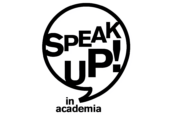Definitions
Uncomfortable? Bullying? Harassment? Abuse of power?
It can start with just a hunch that something is not quite right, or move on to unacceptable behaviours, inappropriate comments – sometimes it can be difficult to recognize when behaviour crosses the red line, especially if it has been ongoing for some time, or is embedded within the working culture. This section seeks to provide some accessible definitions and guidelines that can help define whether what you are seeing or experiencing falls within the realm of abuse of power.
sexual harrassment
On the Swiss federal website you can find a good overview of sexual harrassment at the workplace.
bullying
Bullying represents several inappropriate behaviours that are intended to hurt someone. They are usually performed indirectly over longer periods of time. The harm does not limit to physical harm, but includes emotional and mental harm, as well. Examples of bullying are, but are not limited to:
- physical harm
- name calling
- cyberbullying
- unfair working or studying conditions
- social and emotional bullying
- sexual harassment and abuse
- discrimination
- racism
- anti LGBTQ+ behaviours
mobbing
Mobbing has many similarities with bullying, however, there is one important difference between the two. Bullying usually describes inappropriate behaviours from an individual towards a victim, while mobbing represents the inappropriate behaviour of a group of people towards the victim. Mobbing is a systemic phenomenon happening on structural levels. Inappropriate behaviours include, but are not limited to:
- hostile statements, humiliation and malicious gossip
- unfair or inappropriate working tasks and conditions
- social exclusion and isolation
- intimidation
- ignorance and/or disapproval of suggestions, ideas and initiatives
- verbal and physical aggression
- emotional abuse
Sources:
- Journal of the International Ombudsman Association, Volume 3, Number 2, 2010
- lives-nccr.ch
- Mobbing, Causes Consequences and Solutions; Maureen Duffy and Len Sperry, Oxford University Press, 2012
definitions
Uncomfortable? Bullying? Harassment? Abuse of power?
It can start with just a hunch that something is not quite right, or move on to unacceptable behaviours, inappropriate comments – sometimes it can be difficult to recognize when behaviour crosses the red line, especially if it has been ongoing for some time, or is embedded within the working culture. This section seeks to provide some accessible definitions and guidelines that can help define whether what you are seeing or experiencing falls within the realm of abuse of power.
sexual harrassment
On the Swiss federal website you can find a good overview of sexual harrassment at the workplace.
bullying
Bullying represents several inappropriate behaviours that are intended to hurt someone. They are usually performed indirectly over longer periods of time. The harm does not limit to physical harm, but includes emotional and mental harm, as well. Examples of bullying are, but are not limited to:
- physical harm
- name calling
- cyberbullying
- unfair working or studying conditions
- social and emotional bullying
- sexual harassment and abuse
- discrimination
- racism
- anti LGBTQ+ behaviours
mobbing
Mobbing has many similarities with bullying, however, there is one important difference between the two. Bullying usually describes inappropriate behaviours from an individual towards a victim, while mobbing represents the inappropriate behaviour of a group of people towards the victim. Mobbing is a systemic phenomenon happening on structural levels. Inappropriate behaviours include, but are not limited to:
- hostile statements, humiliation and malicious gossip
- unfair or inappropriate working tasks and conditions
- social exclusion and isolation
- intimidation
- ignorance and/or disapproval of suggestions, ideas and initiatives
- verbal and physical aggression
- emotional abuse
Sources:
- Journal of the International Ombudsman Association, Volume 3, Number 2, 2010
- lives-nccr.ch
- Mobbing, Causes Consequences and Solutions; Maureen Duffy and Len Sperry, Oxford University Press, 2012
definitions
Uncomfortable? Bullying? Harassment? Abuse of power?
It can start with just a hunch that something is not quite right, or move on to unacceptable behaviours, inappropriate comments – sometimes it can be difficult to recognize when behaviour crosses the red line, especially if it has been ongoing for some time, or is embedded within the working culture. This section seeks to provide some accessible definitions and guidelines that can help define whether what you are seeing or experiencing falls within the realm of abuse of power.
sexual harrassment
On the Swiss federal website you can find a good overview of sexual harrassment at the workplace.
bullying
Bullying represents several inappropriate behaviours that are intended to hurt someone. They are usually performed indirectly over longer periods of time. The harm does not limit to physical harm, but includes emotional and mental harm, as well. Examples of bullying are, but are not limited to:
- physical harm
- name calling
- cyberbullying
- unfair working or studying conditions
- social and emotional bullying
- sexual harassment and abuse
- discrimination
- racism
- anti LGBTQ+ behaviours
mobbing
Mobbing has many similarities with bullying, however, there is one important difference between the two. Bullying usually describes inappropriate behaviours from an individual towards a victim, while mobbing represents the inappropriate behaviour of a group of people towards the victim. Mobbing is a systemic phenomenon happening on structural levels. Inappropriate behaviours include, but are not limited to:
- hostile statements, humiliation and malicious gossip
- unfair or inappropriate working tasks and conditions
- social exclusion and isolation
- intimidation
- ignorance and/or disapproval of suggestions, ideas and initiatives
- verbal and physical aggression
- emotional abuse
Sources:
- Journal of the International Ombudsman Association, Volume 3, Number 2, 2010
- lives-nccr.ch
- Mobbing, Causes Consequences and Solutions; Maureen Duffy and Len Sperry, Oxford University Press, 2012
